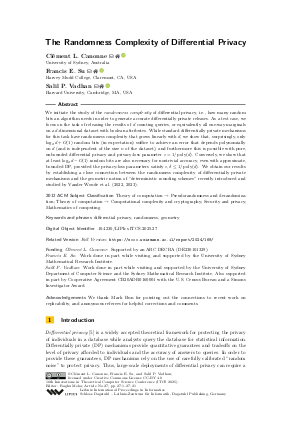The Randomness Complexity of Differential Privacy
Authors
Clément L. Canonne  ,
Francis E. Su
,
Francis E. Su  ,
Salil P. Vadhan
,
Salil P. Vadhan 
-
Part of:
Volume:
16th Innovations in Theoretical Computer Science Conference (ITCS 2025)
Part of: Series: Leibniz International Proceedings in Informatics (LIPIcs)
Part of: Conference: Innovations in Theoretical Computer Science Conference (ITCS) - License:
 Creative Commons Attribution 4.0 International license
Creative Commons Attribution 4.0 International license
- Publication Date: 2025-02-11
File

PDF
LIPIcs.ITCS.2025.27.pdf
- Filesize: 1.7 MB
- 21 pages
Document Identifiers
Related Versions
- Full Version https://eccc.weizmann.ac.il/report/2024/169/
Subject Classification
ACM Subject Classification
- Theory of computation → Pseudorandomness and derandomization
- Theory of computation → Computational complexity and cryptography
- Security and privacy
- Mathematics of computing
Keywords
- differential privacy
- randomness
- geometry
Metrics
- Access Statistics
-
Total Accesses (updated on a weekly basis)
0PDF Downloads0Metadata Views
Abstract
We initiate the study of the randomness complexity of differential privacy, i.e., how many random bits an algorithm needs in order to generate accurate differentially private releases. As a test case, we focus on the task of releasing the results of d counting queries, or equivalently all one-way marginals on a d-dimensional dataset with boolean attributes. While standard differentially private mechanisms for this task have randomness complexity that grows linearly with d, we show that, surprisingly, only log₂ d+O(1) random bits (in expectation) suffice to achieve an error that depends polynomially on d (and is independent of the size n of the dataset), and furthermore this is possible with pure, unbounded differential privacy and privacy-loss parameter ε = 1/poly(d). Conversely, we show that at least log₂ d-O(1) random bits are also necessary for nontrivial accuracy, even with approximate, bounded DP, provided the privacy-loss parameters satisfy ε,δ ≤ 1/poly(d). We obtain our results by establishing a close connection between the randomness complexity of differentially private mechanisms and the geometric notion of "deterministic rounding schemes" recently introduced and studied by Vander Woude et al. (2022, 2023).
Cite As Get BibTex
Clément L. Canonne, Francis E. Su, and Salil P. Vadhan. The Randomness Complexity of Differential Privacy. In 16th Innovations in Theoretical Computer Science Conference (ITCS 2025). Leibniz International Proceedings in Informatics (LIPIcs), Volume 325, pp. 27:1-27:21, Schloss Dagstuhl – Leibniz-Zentrum für Informatik (2025)
https://doi.org/10.4230/LIPIcs.ITCS.2025.27
BibTex
@InProceedings{canonne_et_al:LIPIcs.ITCS.2025.27,
author = {Canonne, Cl\'{e}ment L. and Su, Francis E. and Vadhan, Salil P.},
title = {{The Randomness Complexity of Differential Privacy}},
booktitle = {16th Innovations in Theoretical Computer Science Conference (ITCS 2025)},
pages = {27:1--27:21},
series = {Leibniz International Proceedings in Informatics (LIPIcs)},
ISBN = {978-3-95977-361-4},
ISSN = {1868-8969},
year = {2025},
volume = {325},
editor = {Meka, Raghu},
publisher = {Schloss Dagstuhl -- Leibniz-Zentrum f{\"u}r Informatik},
address = {Dagstuhl, Germany},
URL = {https://drops.dagstuhl.de/entities/document/10.4230/LIPIcs.ITCS.2025.27},
URN = {urn:nbn:de:0030-drops-226556},
doi = {10.4230/LIPIcs.ITCS.2025.27},
annote = {Keywords: differential privacy, randomness, geometry}
}
Author Details
Funding
- Canonne, Clément L.: Supported by an ARC DECRA (DE230101329).
- Su, Francis E.: Work done in part while visiting and supported by the University of Sydney Mathematical Research Institute.
- Vadhan, Salil P.: Work done in part while visiting and supported by the University of Sydney Department of Computer Science and the Sydney Mathematical Research Institute. Also supported in part by Cooperative Agreement CB20ADR0160001 with the U.S. Census Bureau and a Simons Investigator Award.
Acknowledgements
We thank Mark Bun for pointing out the connections to recent work on replicability, and anonymous referees for helpful corrections and comments.
References
- Mark Bun, Marco Gaboardi, Max Hopkins, Russell Impagliazzo, Rex Lei, Toniann Pitassi, Satchit Sivakumar, and Jessica Sorrell. Stability is stable: Connections between replicability, privacy, and adaptive generalization. In Proceedings of the 55th Annual ACM Symposium on Theory of Computing, STOC 2023, pages 520-527, New York, NY, USA, 2023. Association for Computing Machinery. URL: https://doi.org/10.1145/3564246.3585246.
- Mark Bun, Kobbi Nissim, Uri Stemmer, and Salil Vadhan. Differentially private release and learning of threshold functions. In Proceedings of the 56th Annual IEEE Symposium on Foundations of Computer Science (FOCS `15), pages 634-649. IEEE, 18-20 october 2015. Full version posted as arXiv:1504.07553. URL: https://arxiv.org/abs/1504.07553.
- Jesus A De Loera, Elisha Peterson, and Francis Edward Su. A polytopal generalization of Sperner’s lemma. Journal of Combinatorial Theory, Series A, 100(1):1-26, 2002. URL: https://doi.org/10.1006/JCTA.2002.3274.
-
Peter Dixon, A. Pavan, Jason Vander Woude, and N. V. Vinodchandran. List and certificate complexities in replicable learning. In Proceedings of the 37th International Conference on Neural Information Processing Systems (NeurIPS `23), NeurIPS '23, Red Hook, NY, USA, 2023. Curran Associates Inc.

- Cynthia Dwork, Frank McSherry, Kobbi Nissim, and Adam Smith. Calibrating noise to sensitivity in private data analysis. In Theory of cryptography, volume 3876 of Lecture Notes in Comput. Sci., pages 265-284. Springer, Berlin, 2006. URL: https://doi.org/10.1007/11681878_14.
- Cynthia Dwork and Aaron Roth. The algorithmic foundations of differential privacy. Found. Trends Theor. Comput. Sci., 9(3-4):211-407, 2014. URL: https://doi.org/10.1561/0400000042.
- Simson L. Garfinkel and Philip Leclerc. Randomness concerns when deploying differential privacy. In WPES@CCS, pages 73-86. ACM, 2020. URL: https://doi.org/10.1145/3411497.3420211.
- Badih Ghazi, Ravi Kumar, and Pasin Manurangsi. User-level differentially private learning via correlated sampling. In Marc'Aurelio Ranzato, Alina Beygelzimer, Yann N. Dauphin, Percy Liang, and Jennifer Wortman Vaughan, editors, Advances in Neural Information Processing Systems 34: Annual Conference on Neural Information Processing Systems 2021, NeurIPS 2021, December 6-14, 2021, virtual, pages 20172-20184, 2021. URL: https://proceedings.neurips.cc/paper/2021/hash/a89cf525e1d9f04d16ce31165e139a4b-Abstract.html.
- Ilya Mironov, Omkant Pandey, Omer Reingold, and Salil Vadhan. Computational differential privacy. In S. Halevi, editor, Advances in Cryptology - CRYPTO `09, volume 5677 of Lecture Notes in Computer Science, pages 126-142. Springer-Verlag, 16-20 august 2009. URL: https://doi.org/10.1007/978-3-642-03356-8_8.
- Salil P. Vadhan. The complexity of differential privacy. In Tutorials on the Foundations of Cryptography, pages 347-450. Springer International Publishing, 2017. URL: https://doi.org/10.1007/978-3-319-57048-8_7.
- Jason Vander Woude, Peter Dixon, Aduri Pavan, Jamie Radcliffe, and N. V. Vinodchandran. Geometry of rounding. CoRR, abs/2211.02694, 2022. URL: https://doi.org/10.48550/arXiv.2211.02694.
- Jason Vander Woude, Peter Dixon, Aduri Pavan, Jamie Radcliffe, and N. V. Vinodchandran. Geometry of rounding: Near optimal bounds and a new neighborhood Sperner’s lemma. CoRR, abs/2304.04837, 2023. URL: https://doi.org/10.48550/arXiv.2304.04837.
